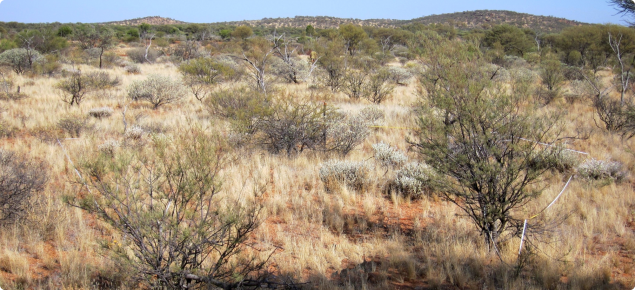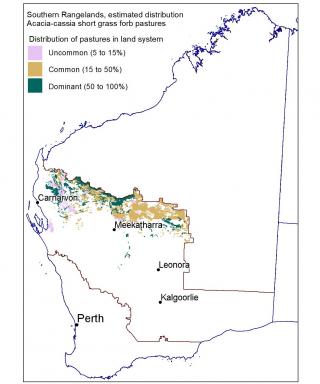Pastoral potential – low
The pastoral value of acacia-cassia short grass forb pastures is generally low. The shrub component of these pastures in good condition provides a valuable reserve in dry times. Very hilly pastures have low accessibility for stock and the pastoral value in these areas is very low.
Suggested levels of use (per annum)
Table 1 provides a rough guide to the range of pastoral values for good condition pastures, which must be checked against conditions in each region and paddock. Carrying capacities for fair condition pastures might be 75% to 50% of good, and poor condition pastures less than 50% of good.
See Introduction to pastures in the southern rangelands of Western Australia for an explanation of how carrying capacities are estimated.
| Condition | Carrying capacity ha/DSE1 | Carrying capacity ha/CU2 (ha/AE3) |
|---|---|---|
| Good | 20–29.9 | 140–209 (168–251) |
1 DSE is based on the feed energy required to maintain a 45 kilogram liveweight Merino wether with zero weight change, no wool growth additional to that included in maintenance, and walking 7 km/day. 1 DSE has an energy requirement of approximately 8.7 MJ ME/day.
2 CU in the southern rangelands is based on a 400 kg steer at maintenance and equivalent to 7 DSE.
3 AE is based on the feed energy to maintain a 450 kg Bos taurus steer 2.25 years of age, walking 7 kilometers each day. 1 AE has an energy requirement of approximately 73 MJ ME/day and equivalent to 8.4 DSE.
Management
Heavy grazing results in the removal of palatable species and a reduction in carrying capacity. Strategic fencing and optimal spacing of water supplies is necessary to achieve full usage of these pastures. Fencing to separate acacia-cassia short grass forb pastures from more productive pastures will allow better management of both types, and reduce the likelihood of preferential grazing of higher pastoral value pastures.
These pastures can be opportunistically grazed after good seasonal rains produce a flush of annual species. That in turn allows managers to spell better quality pastures, where fencing is adequate, to promote recruitment of palatable shrubs.
Pasture condition
Surveyed pasture condition is mostly fair or good but some localised areas show considerable loss of palatable shrubs. Erosion is uncommon where soils are stable and mostly protected by a mantle of stones. Even in very poor condition there is generally no erosion.
Good
See Figure 1. This is indicated by the density and composition of the low shrub layer. A robust and diverse layer with scattered palatable species indicates good condition. Widespread desirable indicator species are warty-leaf eremophila, Wilcox bush, flat leaf bluebush and cotton bush. Other palatable species may include ruby saltbush, felty leaf bluebush and currant bush. Less palatable and unpalatable shrubs are always present. Grey cassia, crinkle leaf cassia and flannel bush are the most widely spread and may be dominant in the low shrub layer. Other unpalatable shrubs expected include poverty bushes at low densities. In good condition total low shrub densities are commonly between 1500 and 3000 plants per hectare. There is no erosion.
Fair
See Figure 2. This is reflected by a reduced total shrub cover – a direct result of the loss of the more palatable species. The density of desirable indicator species is reduced. Few young desirable plants are present and some of the more sensitive indicators such as warty-leaf eremophila, ruby saltbush and flat leaf bluebush are grazed out. Undesirable species such as wait-a-while, bardie bush and needlebush may increase marginally. Total low shrub densities are usually in the vicinity of 1000 plants per hectare and there is no erosion.
Poor
See Figure 3. Few, if any, desirable species are present and the effects of overgrazing are obvious. Grazing pressure is often redirected toward the less palatable shrubs and these may also be heavily grazed and show a decline in density. Understoreys are sparse, sometimes with only undesirable species remaining. Pastures in poor condition can only be grazed on an opportunistic basis to take advantage of annual pastures in favourable seasons. Total low shrub densities may reach 700 plants per hectare.
Acacia–cassia short grass forb pastures condition photographs
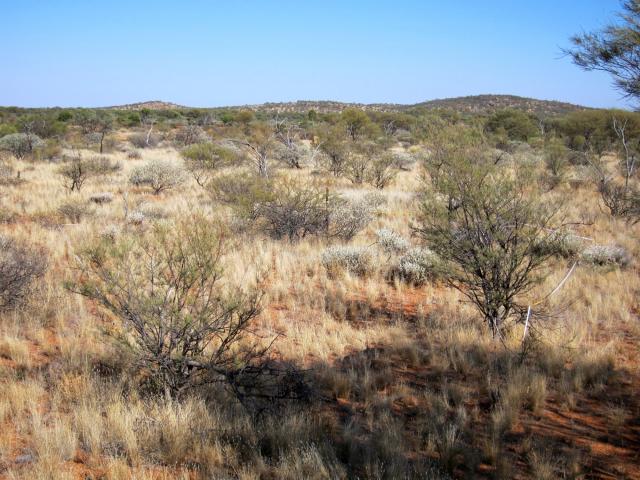
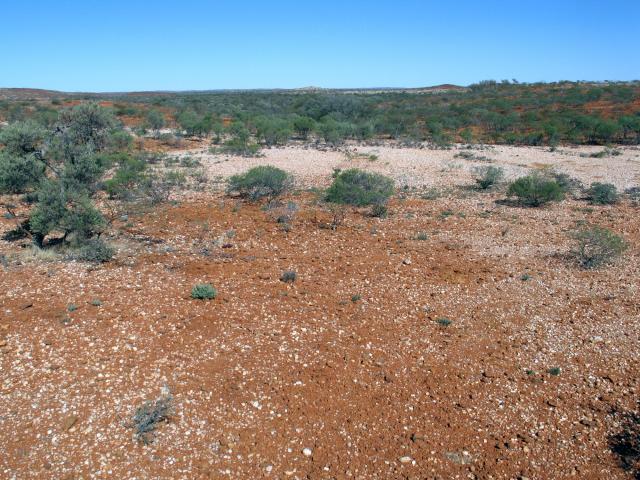
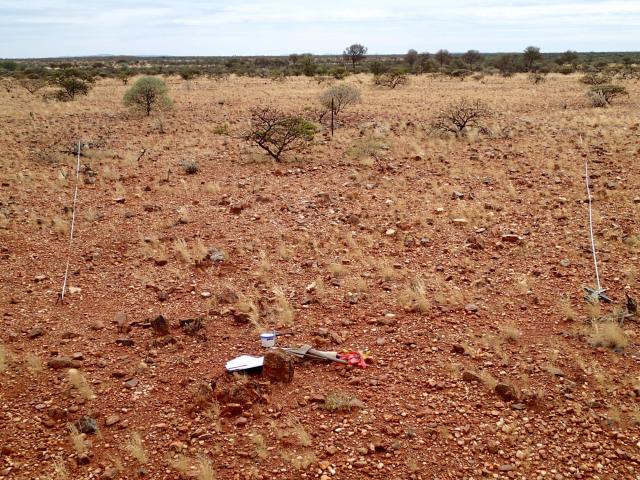
Vegetation structure and composition
Acacia-cassia short grass forb pastures are generally tall (>2 m) shrublands with a prominent low shrub layer mostly of eremophilas and cassias. Projected foliar cover (PFC) ranges from very scattered to scattered (5 to 20%.) They also occur as low (<2 m) shrublands and low (<6 m) open woodlands. Dominant trees in woodlands are usually black mulga and mulga, or spreading gidgee. Mulga dominance is generally restricted to the hilly areas, and spreading gidgee to the lower landscapes. Other trees may include gidgee. The upper stratum can include bowgada, curara, bardie bush and snakewood. Total tall shrub densities are often between 200 and 300 plants per hectare but can range from 25 to >800/ha.
Most good condition pastures are characterised by a diverse low shrub understorey. Grey cassia, crinkle leaf cassia, Wilcox bush and cotton bush are common. Other widespread low shrubs include royal poverty bush, turpentine bush, warty-leaf eremophila, flat leaf bluebush, horse mulla mulla and flannel bush. Total densities vary with pasture condition and position in the landscape, ranging up to 5500 plants per hectare.
Perennial grasses are frequently absent but of local significance on sandier soils. Buck wanderrie grass and other wanderrie grasses may occur. Annual grasses and forbs may be abundant in good seasons.
Occurrence
Acacia-cassia short grass forb pastures generally occur on sandy or loamy, reddish-brown to dark red, lithosols on stony plains, footslopes, hills and plateaux, and cover an estimated 3.3 million hectares (4.1% of the southern rangelands). Soils are usually shallow (20–50 cm) and contain abundant fragments of the underlying parent material (e.g. sandstone, granite). Moderate to dense surface mantles are often present. Texture contrast (duplex), gradationally textured or fine-textured uniform soil profiles may also be present in some areas.
Associated plants
| Common name | Scientific name (links to FloraBase) | Desirability* |
|---|---|---|
| Bluebushes | Maireana spp. | D |
| Compact poverty bush, felty fuchsia bush | Eremophila compacta | D |
| Cotton bush | Ptilotus obovatus | D |
| Felty leaf bluebush | Maireana tomentosa | D |
| Flat leaf bluebush | Maireana planifolia | D |
| Golden bluebush, George's bluebush | Maireana georgei | D |
| Horse mulla mulla | Ptilotus schwartzii | D |
| Lax bluebush | Maireana thesioides | D |
| Mulga bluebush | Maireana convexa | D |
| Mulla mullas | Ptilotus spp. | D |
| Rhagodias | Rhagodia spp. | D |
| Round-leaved eremophila | Eremophila muelleriana | D |
| Ruby saltbush | Enchylaena tomentosa | D |
| Tall sida | Sida calyxhymenia | D |
| Warty-leaf eremophila | Eremophila latrobei | D |
| Wilcox bush | Eremophila forrestii | D |
| Bardie bush | U | |
| Grey cassia, desert cassia | Senna artemisioides subsp. x coriacea | U |
| Grey turpentine bush | Eremophila macmillaniana | U |
| Needlebush | Hakea preissii | U |
| Straight leaf cassia, variable cassia | Senna artemisioides subsp. x sturtii | U |
| Wait-a-while | Acacia cuspidifolia | U |
| Black mulga | Acacia citrinoviridis | I |
| Bloodbush | Senna artemisioides subsp. oligophylla | I |
| Bowgada, wanyu, horse mulga | Acacia ramulosa | I |
| Buck wanderrie grass | Eriachne helmsii | I |
| Crimson eremophila | Eremophila punicea | I |
| Crinkle leaf cassia | Senna artemisioides subsp. helmsii | I |
| Curara, Kurara | Acacia tetragonophylla | I |
| Currant bush | Scaevola spinescens | I |
| Fine-toothed poverty bush | Eremophila georgei | I |
| Flannel bush | Solanum lasiophyllum | I |
| Gidgee, yalardy | Acacia pruinocarpa | I |
| Granite poverty bush | Eremophila platycalyx | I |
| Hop mulga | Acacia craspedocarpa | I |
| Mulga | Acacia aneura | I |
| Royal poverty bush | Eremophila cuneifolia | I |
| Silver cassia, banana-leaf cassia | Senna artemisioides subsp. x artemisioides | I |
| Snakewood | Acacia xiphophylla | I |
| Spreading gidgee | Acacia subtessarogona | I |
| Turpentine bush | Eremophila fraseri | I |
| Woollybutt grass | Eragrostis eriopoda | I |
| Royal mulla mulla | Ptilotus rotundifolius | N |
* D = desirable, U = undesirable, I = intermediate, N = no indicator value

